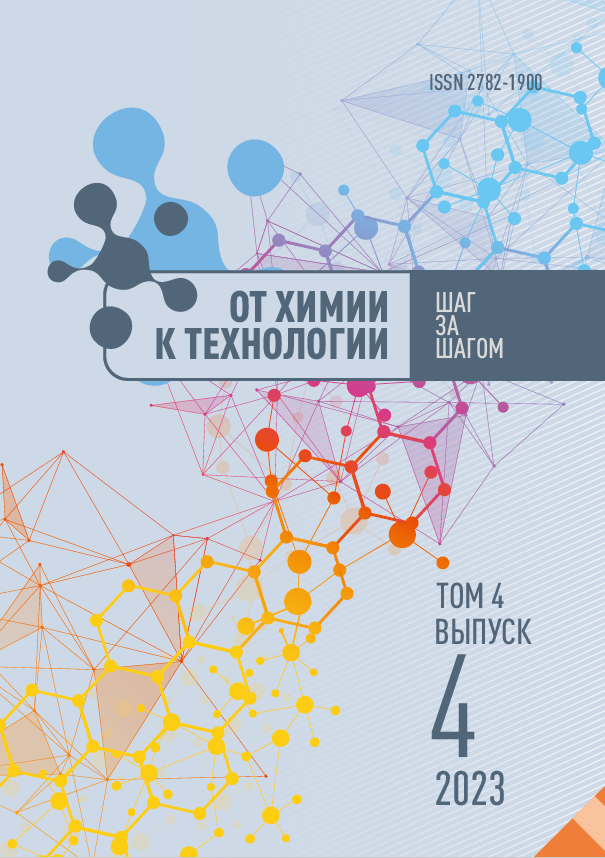Иваново, Ивановская область, Россия
The article considers issues concerning the reaction of exocycle opening in phorbin molecules (on the example of methylpheophorbide a) under the O nucleophiles - water and alcohols action. According to the author, under certain conditions relatively weak nucleophiles as water and alcohols can cause the opening of the exocycle in the molecule of methylpheophorbide a with the formation of chlorine derivatives e6. The study of this reaction, in addition, reveals new synthetic methods to obtain chlorine e6 esters of different degrees of substitution, and eventually - free chlorine e6 in the form of triacids. Free chlorine is a valuable photosensitiser for photodynamic therapy (PDT), and a starting compound for the preparation of other photosensitizers. The article also discusses possible synthetic approaches to obtain free chlorine e6.
phorbines, O-nucleophiles; exocycle uncoupling, chlorine e6 derivatives, photosensitisers
1. Mironov, A.F. (2004) Current state of chemistry of photosensitisers based on natural porphyrins, chlorines and bacteriochlorines, Uspexi khimii porfirinov, 4, pp. 271-289 (in Russian).
2. Agostinis, P., Berg, K., Cengel, K.A. et al. (2011) Photodynamic therapy of cancer: an update, CA Cancer J. Clin., 61(4), pp. 250-281. DOI:https://doi.org/10.3322/caac.20114.
3. Cabuy, E. (2012) Photodynamic therapy in cancer treatment. RCT summary for professionals, Reliable cancer therapies. Energy-based therapies, 3(2), pp. 1-54.
4. Tsyb, A.F., Kaplan, M.A., Romanko, Y.S. & Popuchiev, V.V. (2009) Clinical aspects of photodynamic therapy. Kaluga: Izd-vo nauch. lit-ry (in Russian).
5. Van Straten, D., Mashayekhi, V., De Bruijn, H.S., Oliveira, S. & Robinson, D.J. (2017) Oncologic photodynamic therapy: basic principles, current clinical status and future directions, Cancers, 9(19), pp. 1-54. DOI:https://doi.org/10.3390/cancers9020019.
6. Bonnett, R. (2000) Chemical aspects of photodynamic therapy. Amsterdam: Gordon and Breach Science Publishers.
7. Kustov, A.V., Berezin, D.B., Strelnikov, A.I. & Lapochkina, N.P. (2020) Antitumour and antimicrobial photodynamic therapy: mechanisms, targets, clinical and laboratory studies. Moscow: Largo (in Russian).
8. Koifman, O.I. et.al. (2022) Synthetic strategy of tetrapyrrolic photosensitizers for their practical application in photodynamic therapy, Macroheterocycles, 15(4), pp. 207-304. DOI:https://doi.org/10.6060/mhs224870k.
9. Berezin, D.B., Karimov, D.R. & Kustov, A.V. (2018) Corroles and their derivatives: synthesis, properties, prospects of practical application. M.: LENAND (in Russian).
10. Karimov, D.R., Berezin, D.B., Tomilova, I.K. (2020) Corroles as aromatic analogs of corrinoids and vitamin B12: synthesis, structural fea-tures and macrocycle properties, perspectives of material chemistry on corrole basis, From Chemistry Towards Technology Step-by-Step, 1(1), pp. 9-55. DOI:https://doi.org/10.52957/27821900_202020_01_9 [online]. Available at: http://chemintech.ru/index.php/tor/2020tom1n1 (accessed 10.09.2023).
11. Pandey, S.K., Sajjad, M., Chen, Y., Zheng, X., Yao, R., Missert, J.R., Batt, C., Nabi, H.A., Oseroff, A.R. & Pandey, R.K. (2009) Comparative Positron-Emission Tomography (PET) Imaging and Phototherapeutic Potential of 124I- Labeled Methyl-3-(1′-iodobenzyloxyethyl)pyropheophorbide-a vs the Corresponding Glucose and Galactose Conjugates, J. Med. Chem., 52, pp. 445–455. DOI:https://doi.org/10.1021/jm8012213.
12. Zhang, M., Zhang, Z., Blessington, D., Li, H., Busch, T.M., Madrak, V., Miles, J., Chance, B., Glickson, J.D., Zheng, G. (2003) Pyropheophorbide 2-Deoxyglucosamide: A New Photosensitizer Targeting Glucose Transporters, Bioconjugate Chem., 14, pp. 709–714. DOI:https://doi.org/10.1021/bc034038n.
13. Varchi, G., Rapozzi, V., Ragno, D., Castoria, G., Di Donato, M., Pietra, E.D., Benfenati, V., Ferroni, C., Guerrini, A., Cesselli, D. & Saracino, E. (2015) Androgen receptor targeted conjugate for bimodal photodynamic therapy of prostate cancer in vitro, Bioconjugate Chem., 26(8), pp. 1662–1671. DOI:https://doi.org/10.1021/acs.bioconjchem.5b00261.
14. Tegos, G.P., Anbe, M., Yang, Ch., Demidova, T.N., Satti, M., Mroz, P., Janjua, S., Gad, F. & Hamblin, M.R. (2006) Protease-Stable Polycationic Photosensitizer Conjugates between Polyethyleneimine and Chlorin(e6) for Broad-Spectrum Antimicrobial Photoinactivation, Antimicrobial Agents and Chemotherapy, 50(4), pp. 1402-1410. DOI:https://doi.org/10.1128/aac.50.4.1402-1410.2006.
15. Hamblin, M.R. (2016) Antimicrobial photodynamic inactivation: a bright new technique to kill resistant microbes, Current opinion in Microbiology, 33, pp. 67-73. DOI:https://doi.org/10.1016/j.mib.2016.06.008.
16. Kustov, A.V., Morshnev, Ph. K., Kukushkina, N.V., Smirnova, N.L., Berezin, D.B., Karimov, D.R., Shukhto, O.V., Kustova, T.V., Belykh, D.V., Mal’shakova, M.V., Zorin, V.P. & Zorina, T.E. (2022) Solvation, Cancer Cell Photoinactivation and the Interaction of Chlorin Photosensitizers with a Potential Passive Carrier Non-Ionic Surfactant Tween 80, Int. J. Mol. Sci., 23, pp. 5294-5305 [online]. Available at: https://doi.org/10.3390/ijms23105294 (accessed 09.10.2023).
17. Hynninen, P.H. (1973) Chlorophylls. IV. Preparation and purification of some derivatives of chlorophylls a and b, Acta Chem. Scand., 27, pp. 1771–1780.
18. Belykh, D.V. (2017) Formation of C-O, C-S, C-N and C-C bonds at the periphery of phytochlorines macrocycle during their chemical modification: basic methods and synthetic applications, Russian Chemical Journal, LXI(3), pp. 69-109 (in Russian).
19. Belykh, D.V., Kopylov, E.A., Gruzdev, I.V. & Kuchin, A.V. (2010) Opening of the exocycle of methylpheophorbide under the action of amines as a one-step method of introduction of additional fragments on the periphery of the chlorine macrocycle, Zhurn. org. khimii, 46(4), pp. 584-592 (in Russian).
20. Nikolaeva, I.A., Misharin, A.Yu., Ponomarev, G.V., Timofeev, V.P. & Tkachev, Ya.V. (2010) Chlorin e6 cholesterol conjugate and its copper complex. Simple synthesis and entrapping in phospholipid vesicles, Bioorg. Med. Chem. Lett., 20, pp. 2872-2875. DOI:https://doi.org/10.1016/j.bmcl.2010.03.041.
21. Gushchina, O.I., Larkina, E.A., Nikolskaya, T.A. & Mironov, A.F. (2015) Synthesis of amide derivatives of chlorin e6 and investigation of their biological activity, J. Photochem. Photobiol. B: Biology, 153, pp. 76–81. DOI:https://doi.org/10.1016/j.jphotobiol.2015.09.007.
22. Hargus, J.A., Fronczek, F.R., Vicente, M.G.H. & Smith, K.M. (2007) Mono-(L)-aspartylchlorin-e6, Photochemistry and Photobiology, 83, pp. 1006-1015. DOI:https://doi.org/10.1111/j.1751-1097.2007.00092.x.
23. Jinadasa, R.G.W., Hu, X., Vicente, M.G.H. & Smith, K.M. (2011) Syntheses and cellular investigations of 173-, 152-, and 131-amino acid derivatives of chlorin e6, J. Med. Chem., 54, pp. 7464-7476. DOI:https://doi.org/10.1021/jm2005139.
24. Askarov, K.A., Berezin, B.D., Evstigneeva, R.P. et al. (1985) Porphyrins: structure, properties, synthesis. Moscow: Nauka (in Russian).
25. Taima, H., Okubo, A., Yoshioka, N. & Inoue, H. (2005) Synthesis of cationic water-soluble esters of chlorin e6, Tetrahedron Lett., 46, pp. 4161–4164. DOI:https://doi.org/10.1016/j.tetlet.2005.04.069.
26. Koifman, O.I. & Ponomarev, G.V. (2013) Method for obtaining methylpheophorbide (A). 2490273 RF.
27. Makarov, V.V. (2023) Synthesis and physicochemical characteristics of tetrapyrrole macrocycles with polar groups for antimicrobial photodynamic therapy. PhD. Ivanovo (in Russian).
28. Tulaeva, L.A., Belykh, D.V., Yakovleva, N.M., Sel'kova, I.A., Rocheva, A.V. & Kuchin, A.V. (2006) Synthesis and study of chlorophyll derivatives containing a free carboxyl group, Khimiya i khimicheskaya texnologiya, 49(4), pp. 82-87 (in Russian).
29. Berezin, M.B. (1993) Solvation of chlorophyll and related compounds. PhD. Ivanovo (in Russian).







